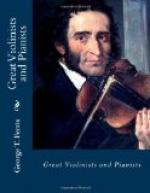and also by Franz Liszt, then rising almost on the
top wave of his dazzling fame as a virtuoso.
Liszt was a profound admirer of the less fortunate
Schumann, and did everything possible to make him a
favorite with the public, but for a long time in vain.
Liszt writes of this as follows: “Since
my first knowledge of his compositions I had played
many of them in private circles at Milan and Vienna,
without having succeeded in winning the approbation
of my hearers. These works were, fortunately
for them, too far above the then trivial level of taste
to find a home in the superficial atmosphere of popular
applause. The public did not fancy them, and
few players understood them. Even in Leipzig,
where I played the ‘Carnival’ at my second
Gewandhaus concert, I did not obtain my customary
applause. Musicians, even those who claimed to
be connoisseurs also, carried too thick a mask over
their ears to be able to comprehend that charming
‘Carnival,’ harmoniously framed as it is,
and ornamented with such rich variety of artistic fancy.
I did not doubt, however, but that this work would
eventually win its place in general appreciation beside
Beethoven’s thirty-three variations on a theme
by Diabelli (which work it surpasses, according to
my opinion, in melody, richness, and inventiveness).”
Both as a composer and writer on music, Schumann embodied
his deep detestation of the Philistinism and commonplace
which stupefied the current opinions of the time, and
he represented in Germany the same battle of the romantic
in art against what was known as the classical which
had been carried on so fiercely in France by Berlioz,
Liszt, and Chopin.
III.
The year 1840 was one of the most important in Schumann’s
life. In February he was created Doctor of Philosophy
in the University of Jena, and, still more precious
boon to the man’s heart, Wieck’s objections
to the marriage with Clara had been so far melted
away that he consented, though with reluctance, to
their union. The marriage took place quietly
at a little church in Schonfeld, near Leipzig.
This year was one of the most fruitful of Schumann’s
life. His happiness burst forth in lyric forms.
He wrote the amazing number of one hundred and thirty-eight
songs, among which the more famous are the set entitled
“Myrtles,” the cycles of song from Heine,
dedicated to Pauline Viardot, Chamisso’s “Woman’s
Love and Life,” and Heine’s “Poet
Love.” Schumann as a song-writer must be
called indeed the musical reflex of Heine, for his
immortal works have the same passionate play of pathos
and melancholy, the sharp-cut epigrammatic form, the
grand swell of imagination, impatient of the limits
set by artistic taste, which characterize the poet
themes. Schumann says that nearly all the works
composed at this time were written under Clara’s
inspiration solely. Blest with the continual
companionship of a woman of genius, as amiable as she
was gifted, who placed herself as a gentle mediator




